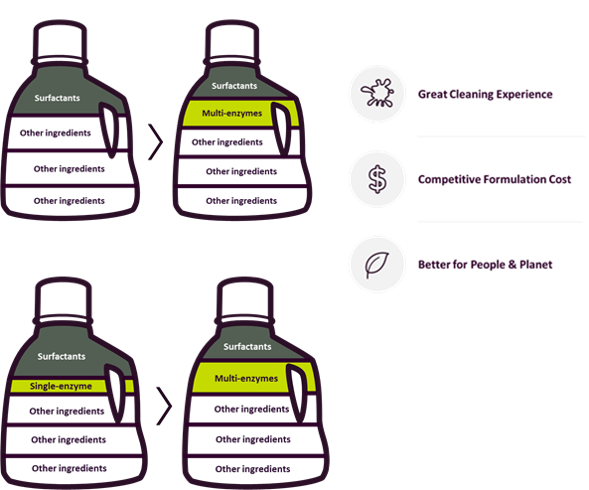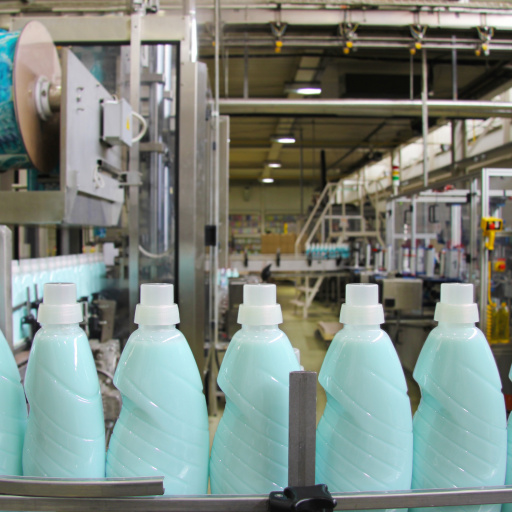Turn cost challenges and market uncertainties into opportunities
Turn cost challenges and market uncertainties into opportunities
Reformulating cleaning products with enzymes can reduce your exposure to market uncertainties and bring new, performance-driven business opportunities.
Novozymes can help.
Extreme weather conditions, the global pandemic, and pressures on logistic chains have recently resulted in price and supply pressures on key detergent raw materials. These, in turn, have hit operational efficiency, fostered uncertainty, and cost businesses a lot of money for manufacturers across South East Asia.
Ways to attain a more stable cost structure and supply

Ways to attain a more stable cost structure and supply
By partially replacing surfactants with enzymes, you can reduce your formulation costs without compromising on performance.
Enzymes originate from nature and as a result, are not as dependent on fossil supply chains that make them less vulnerable to fluctuating raw material prices and availability– and safer for the environment and the people who use them.
Download our new insights paper to learn more about reformulation opportunities.
Enzyme synergy with potential cost-effectiveness can improve your detergent performance
Enzyme synergy with potential cost-effectiveness can improve your detergent performance
Most everyday stains are multi-layered, with each element in the stain forming a layer. A multi-enzyme blend not only targets all the components in a complex stain but also boosts one another’s impact to completely and efficiently remove the stains.
This demonstration in our laboratory shows how multi-enzyme detergents provide better stain removal.
Leverage the benefits of better performance with a more stable enzyme supply chain. Now you have the option to partially replace the surfactants in your detergents and potentially further optimize your formulation costs.

Price volatility and lack of availability of chemical ingredients are a big concern for detergent manufacturers
A detergent mainly consists of chemicals, and when the surfactant cost alone can comprise up to 50% of the raw material cost, this largely impacts detergent manufacturers’ profitability.
A detergent mainly consists of chemicals, and when the surfactant cost alone can comprise up to 50% of the raw material cost, this largely impacts detergent manufacturers’ profitability.
We saw this trend firsthand at Novozymes with the sudden higher demand for cleaning and laundry products during the Covid-19 pandemic (up 25-50% at peak times). As demand suddenly rose, challenging the industry overall in maintaining supply, both our European and American production sites beat production records, meeting our customers’ needs, as well as delivering to customers even faster, to meet urgent requests.
Across our different industries, and particularly in our household care unit, we managed to deliver on time and in full when chemical value chains were in disarray. This demonstrates our ability and dedication to being a trusted partner and supplier — particularly in volatile market conditions.

Local and global events disrupting the chemical ingredients supply
The ongoing issue of climate change will have a big impact on Thailand’s economy. Being the second-largest economy in Southeast Asia, changes in surface temperature, floods and droughts, severe storms and the rise in sea level will no doubt affect the country’s three important sectors: agriculture, tourism and trade.
The global yield of palm oil, where it is extracted to make surfactants, is also heavily affected by weather conditions, labor and logistic challenges, as well as the pandemic. Since April 2020, when Covid-19 reached a global pandemic level, the prices of raw materials often used at detergent manufacturers have fluctuated and, in many cases, increased dramatically.
Extreme weather events are also having an intense effect on the chemical market. The Big Freeze in Texas was first local, but with about 20% of the US chemical industry offline, according to the Independent Commodity Intelligence Services (ICIS), the negative supply impact has become global.
Key chemical feedstocks are being rerouted, driving up prices and causing shortages in other parts of the world. The Big Freeze in Texas or the blockage of the Suez Canal is just some of the latest events in a chain of disruptions to have hit trans-continental chemical supply chains over the years.
It was less than 4 years ago that the heart of the US chemical industry in the Gulf of Mexico was paralyzed due to Hurricane Harvey. Texas used to be spared from hurricanes or polar vortexes, but due to climate change, the chemical industry may need to prepare for a once-in-a-century weather event every 5 years.
Let enzymes unlock critical business value for you during uncertain times
Current times are forcing consumers and businesses around the world to rethink processes, systems, and habits, and to implement more sustainable solutions to balance and protect public health, the economy, the environment, and their business' bottom lines.
There is value for consumers when detergent manufacturers and distributors can keep up with the rising demand for products at the right price and availability, despite interruptions in key raw material supply.
Enzymes are part of the answer to a robust supply chain and continuous delivery of value to consumers.